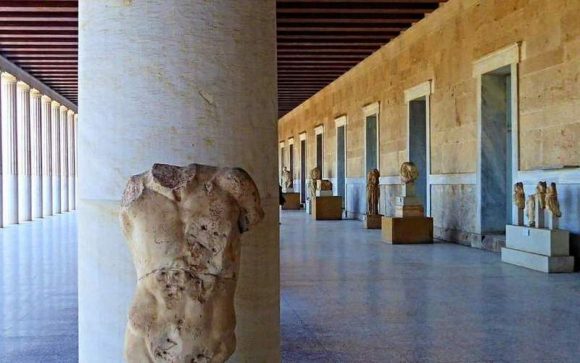The Ancient Greek Agora
The ancient Greek Agora, in other words, the center of the athletic, political and spiritual life of the ancient Greek city-state will be the next place for you to visit.
The Agora was the heart of ancient Athens, the focus of political, commercial, administrative, and social activity, the religious and cultural center, and the seat of justice.
The site was occupied without interruption in all periods of the city’s history. It was used as a residential and burial area as early as the Late Neolithic period (3000 B.C.). Early in the 6th century, in the time of Solon, the Agora became a public area.
After a series of repairs and remodeling, it reached its final rectangular form in the 2nd century B.C. Extensive building activity occurred after the serious damage made by the Persians in 480/79 B.C., by the Romans in 89 B.C., and by the Herulae in A.D. 267 while, after the Slavic invasion in A.D. 580, It was gradually abandoned. From the Byzantine period until after 1834, when Athens became the capital of the independent Greek state, the Agora was again developed as a residential area.
The first excavation campaigns were carried out by the Greek Archaeological Society in 1859-1912, and by the German Archaeological Institute in 1896-97. In 1890-91, a deep trench cut for the Athens-Peiraeus Railway brought to light extensive remains of ancient buildings. In 1931 the American School of Classical Studies started the systematic excavations with the financial support of J. Rockefeller and continued until 1941. Work was resumed in 1945 and is still continuing. In order to uncover the whole area of the Agora it was necessary to demolish around 400 modern buildings covering a total area of ca. 12 hectares.
In the 19th century, the four colossal figures of Giants and Tritons at the facade of the Gymnasium were restored by the Greek Archaeological Society. In the years 1953-56, the Stoa of Attalos was reconstructed to become a museum and in the same period the Byzantine church of Aghioi Apostoloi, built around A.D. 1000, was restored by the American School. Between 1972 and 1975, restoration and preservation work was carried out at the Hephaisteion; the area was cleared of vegetation, and the roof of the temple was repaired in 1978 by the Archaeological Service.
Author
Klio Tsoga, archaeologist
Description of the Greek ancient Agora

The Ancient Agora of Athens is a flat area defined by the Sacred Rock of the Acropolis and the hill of Areopagus in the south and the hill of Kolonos Agoraios in the west. It is traversed by one of the most important ancient roads, the Panathenaic Way, which led to the Acropolis from the main gate of the city, the Dipylon Gate. This road served as the processional way for the great parade of the Panathenaic festival, which was held to honor the city’s patron goddess Athena.
To the north, near the middle of the open square, lay the Altar of the Twelve Gods (522/1 BC). The sanctuary was a popular place of asylum. The altar was also considered the heart of Athens, the central milestone from which distances to outside places were measured.
The most important public buildings and temples of the political, administrative, and religious center of Athens were built from the 6th to the 2nd century BC at the foot of the hill of Kolonos Agoraios, along one of the busiest roads of the Agora, conventionally called West Road.
The Tholos (470 BC), a circular building, served as the headquarters of the fifty prytaneis (officials) of the Boule (senate of 500). The New Bouleuterion was the meeting place of the Boule, the law-making body that drafted law bills for subsequent discussion and approval in the Assembly (Ecclesia). The Metroon (2nd cent. BC) served both as a sanctuary of the Mother of the Gods and the archive building of the city. The Monument of the Eponymous Heroes (350 BC) was a long base for the ten bronze statues representing the eponymous heroes of the ten tribes of Athens. On the West side of the Agora, there are also the remains of the Ionic Temple of Apollo Patroos (Fatherly) (325 BC), so-called because he was the father of Ion, founder of the Ionian Greeks, a tribe that included the Athenians, the cella of the small Temple of Zeus Phratrios and Athena Phratria (350 BC), who were the principle deities of the ancestral religious brotherhoods or phratries, the Stoa of Zeus Eleutherios (of Freedom), whose cult was established after the battle of Plataea in 479 BC when the Greeks drove the Persians out of Greece, and finally the Stoa Basileios (Royal Stoa), the headquarters of the archon basileus, the official responsible for religious matters and the laws.
Overlooking the Agora from the hill to the west (Kolonos Agoraios) is the Temple of Hephaistos and Athena (second half of 5th cent. BC), popularly known as Theseion.
In the northwest area were found the inscribed marble posts which were used to mark the entrances to the Agora wherever a street led into the open square. One of them with the inscription I am the boundary stone of the Agora (500 BC) was found by the house of Simon the cobbler, where Socrates used to meet his pupils.
Further to the northwest starts the valley leading toward the Pnyx. Here are the complex remains of a residential and commercial area, the so-called Industrial District. One larger structure, the Poros Building?, has been tentatively identified as the State Prison (desmoterion) where Socrates was executed.
To the south, the Agora was lined with various public buildings such as the Southwest Fountain House (340-325 BC), Aiakeion -formerly identified as the Heliaia- (early 5th cent. BC), the South Stoa I (430-420 BC), the South Stoa II (2nd cent. BC), the Southeast Fountain House (530-520 BC) and the Mint (400 BC).
The Church of the Holy Apostles, dated to the years around AD 1000, belongs to the byzantine settlement of the area.
The Middle Stoa, was built in the 2nd cent. BC served a primarily commercial function. It divided the old square into two unequal halves. In the northern half of the old Agora square in the years around 15 BC, a large concert hall (odeion) was given to the Athenians by Marcus Vipsanius Agrippa. It was later adorned with a facade using pillars carved in the form of giants and tritons. North of the Odeion lay the ruins of the Doric peripteral temple of Ares, brought in pieces from Pallene and reerected in the Agora during Roman times.
Lining the east side of the Agora square is the Stoa of Attalos (159-138 BC), fully restored to serve as the site museum.
On the north side across modern Hadrian Street, the excavations have revealed another large stoa identified as the Stoa Poikile (namely the Painted Stoa, from the panel paintings that once adorned it).
The Areopagus Hill was a sacred place connected to Ares and the chthonic deities of punishment and vengeance, also called Erinyes (Furies) or Semnes (Venerable Goddesses). It was the place of assembly of the political and judicial body of Areopagus. On the northern edge of the hill, there are the remains of four luxurious houses of the 4th-6th century AD, the so-called philosophical schools, which possibly belonged to sophists. To the south of Areopagus a residential district of the ancient municipality of Kollytos was excavated by the German Archaeological Institute in the 1890s.
Author
Klio Tsoga, archaeologist
Maria Liaska, archaeologist







